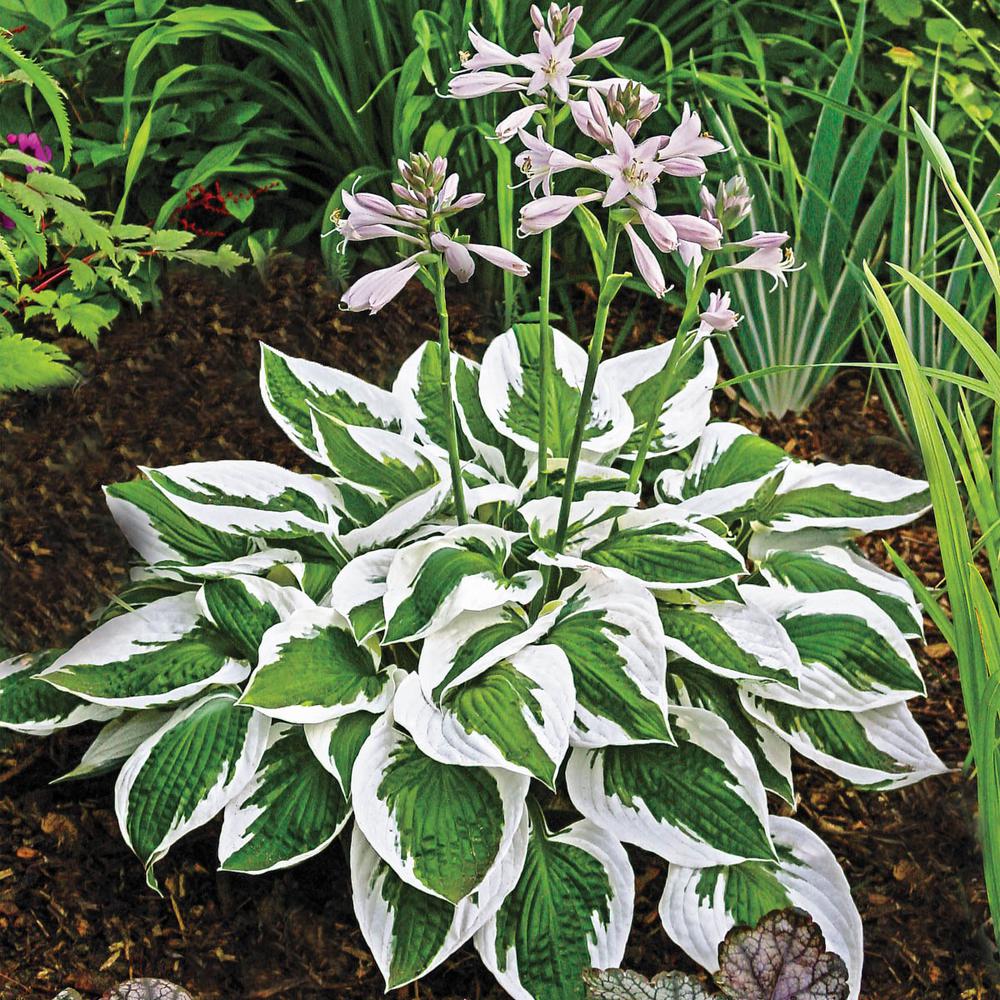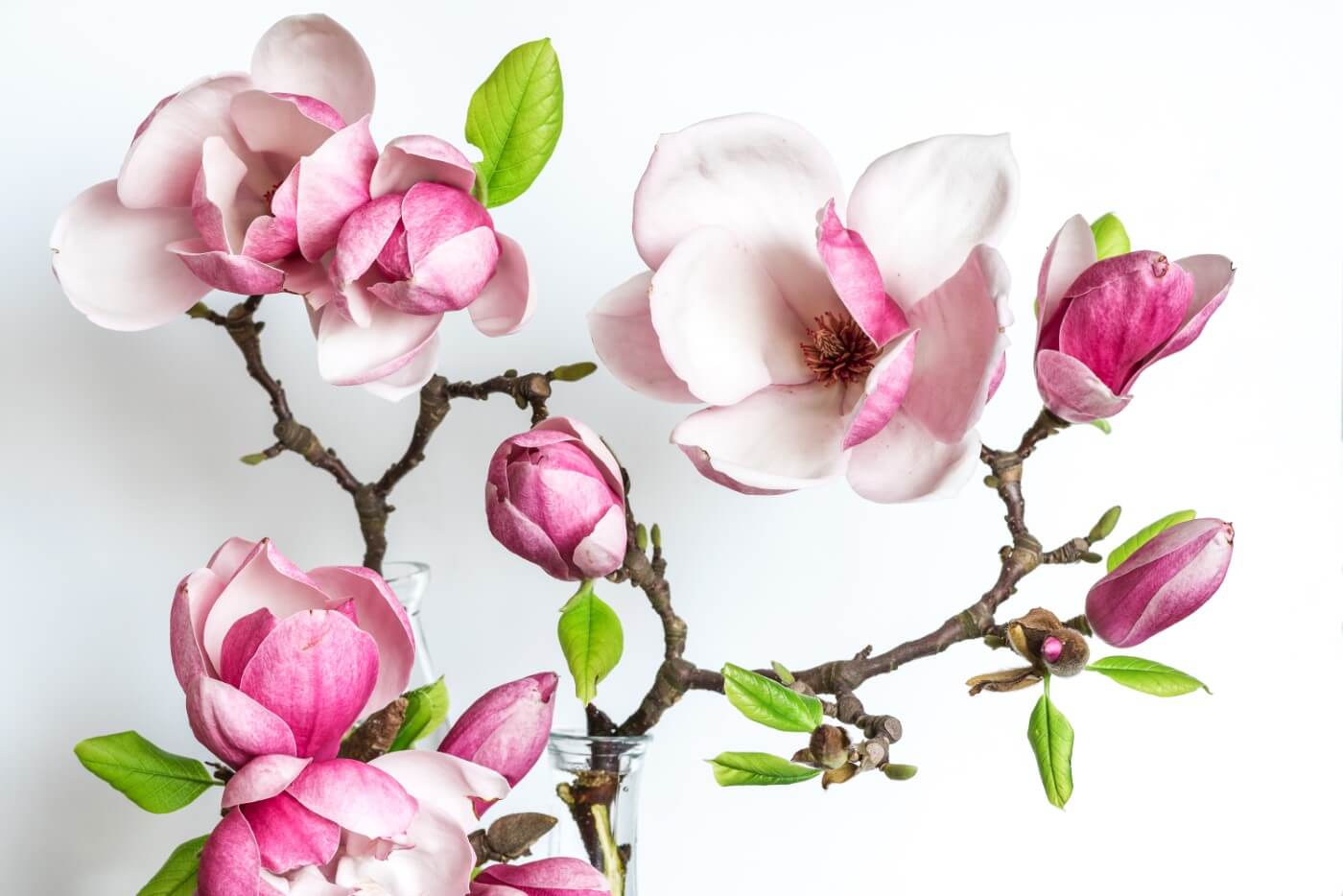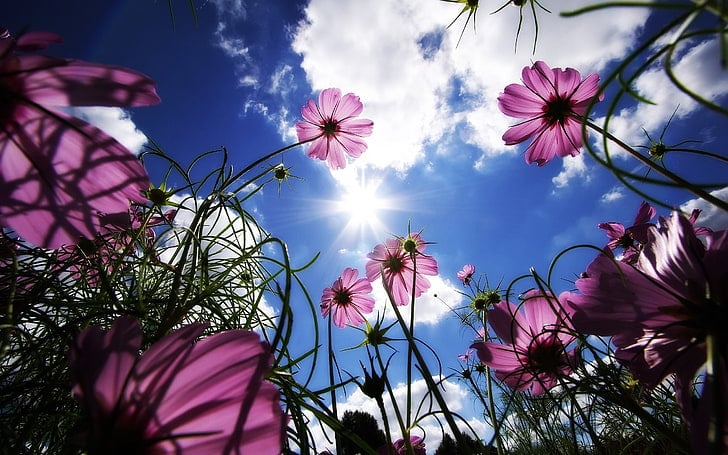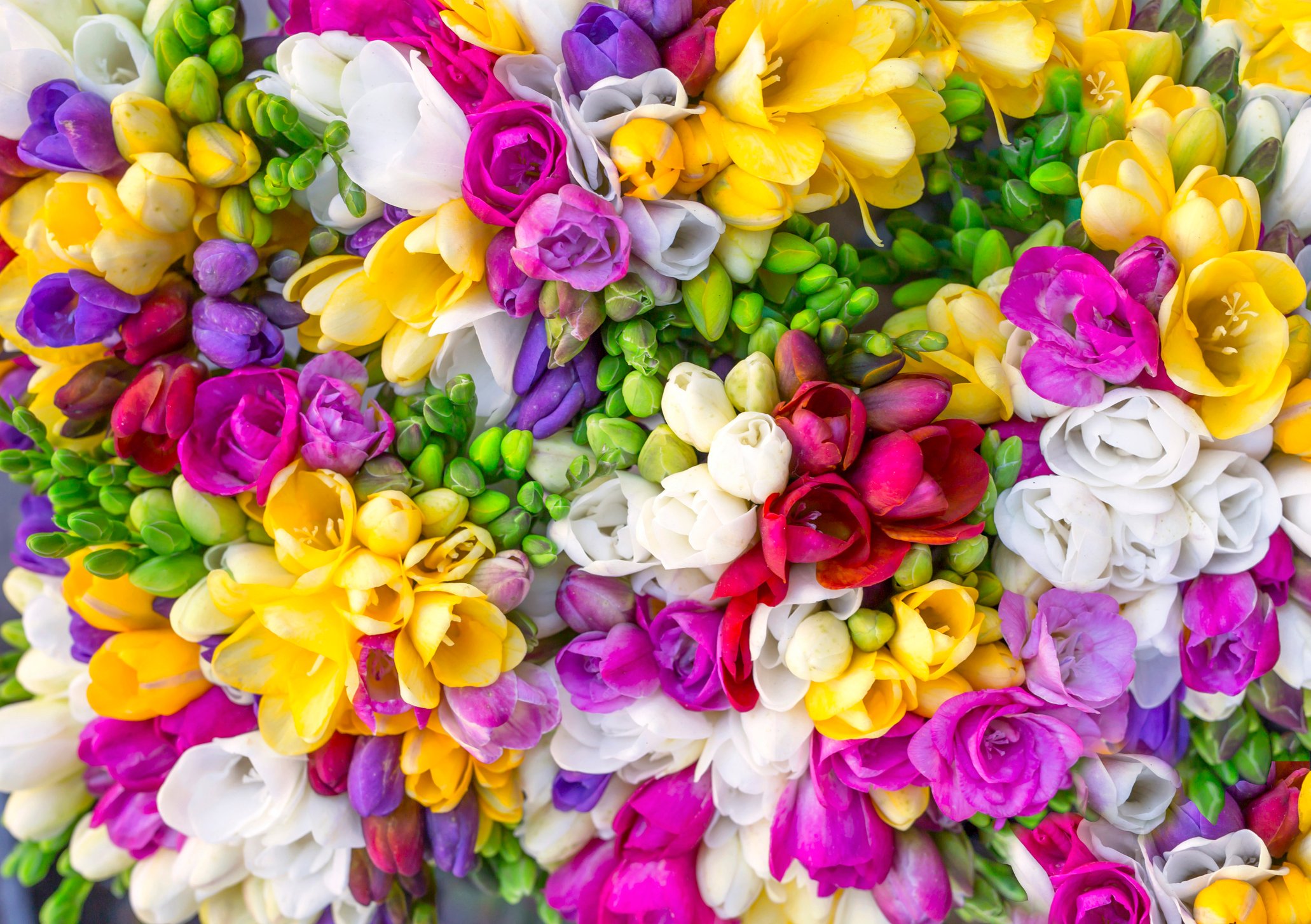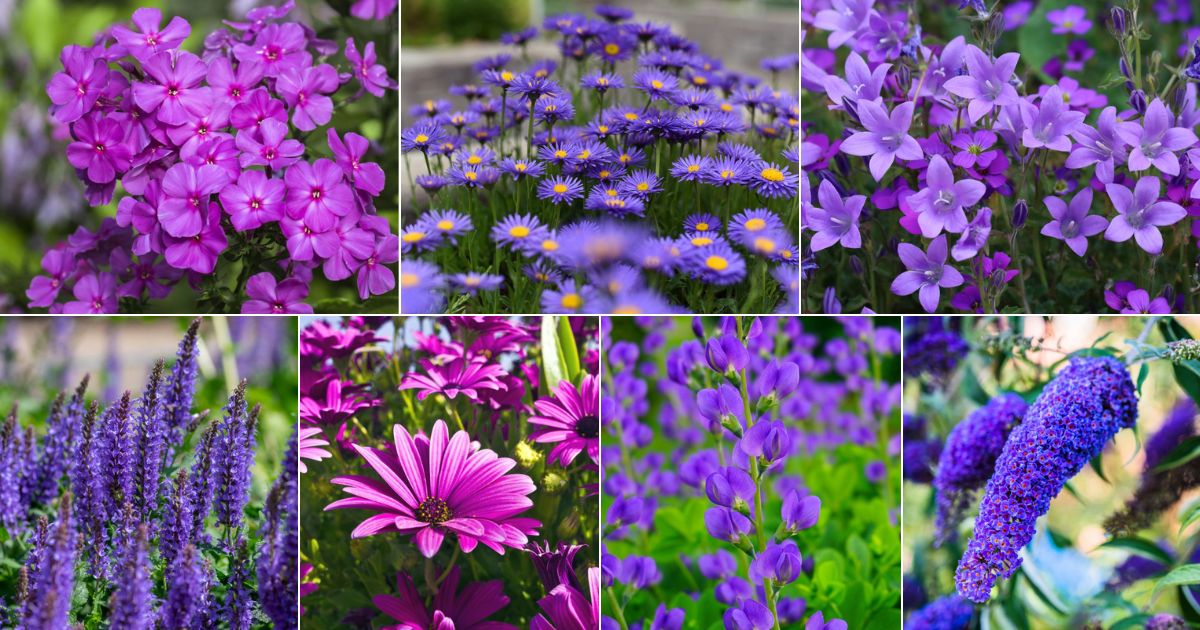10 Gorgeous Blue-Flowering Shrubs & Bushes: With Caring Tips
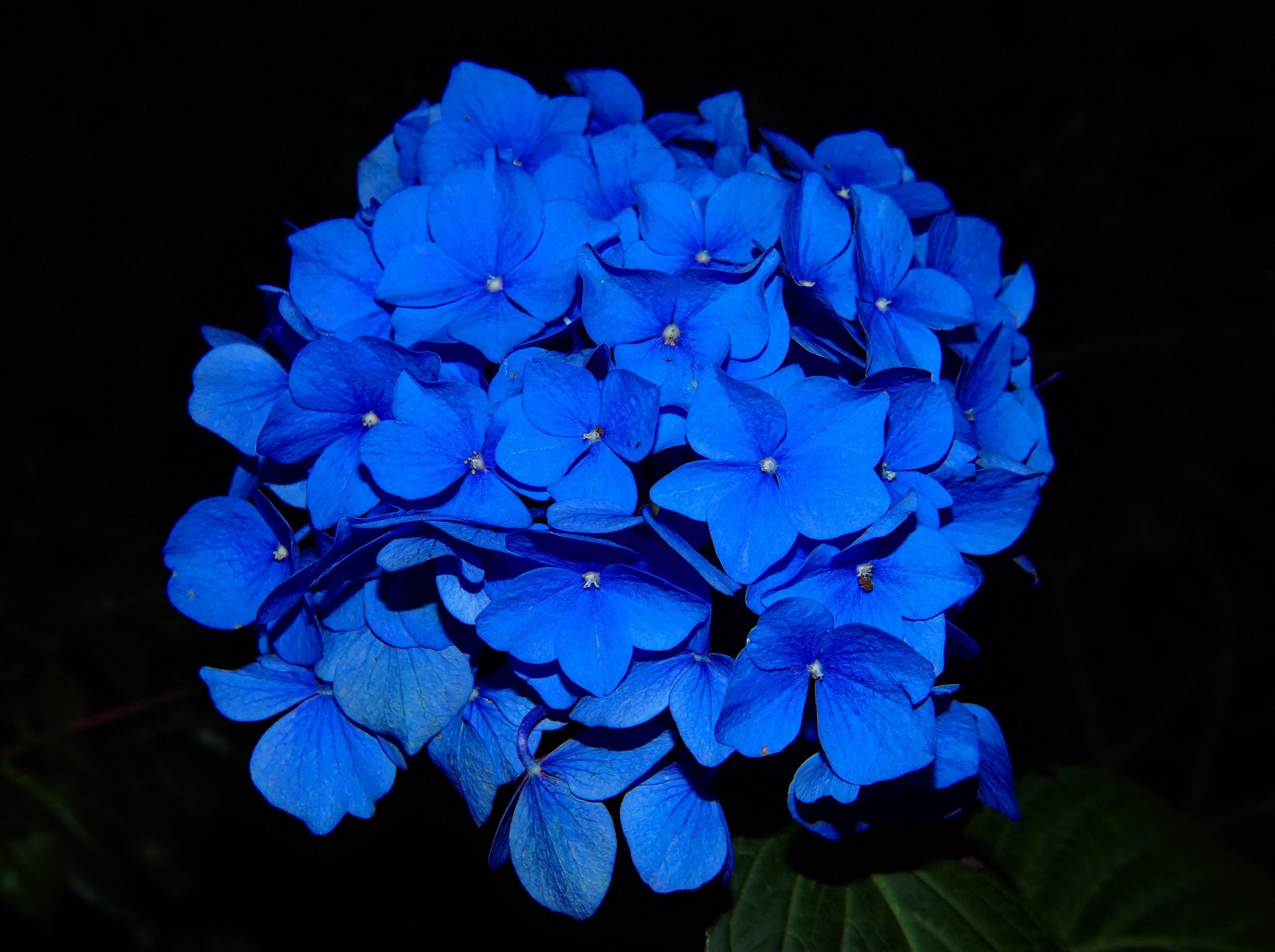
Table of Contents
If it was asked to define nature in two colours, what would they be? Green and Blue, right? Green for the flora and blue for the ocean and sky, but how about involving blue in the flora?
The blue colour is known for its calming properties, bestowing a touch of elegance and beauty upon any garden. Opting for blue-flowing shrubs and bushes proves to be the right choice for any gardener thinking of adding a blue tint to their landscape. The aesthetic appeal aside, these flowers draw in butterflies and bees, providing an added layer of vitality and motion to your outdoor space.
Blue–flowering shrubs and bushes have the potential to infuse your garden with a sense of elegance and serenity. On top of that, the blue colour is proven to be a sound absorber, making them particularly well-suited for city gardens. In this article, we will encounter the top 10 bushes with blue flowers, along with some caring tips and a special mention at the end!
List of 10 Shrubs and Bushes with Blue Flowers
1. Lavender
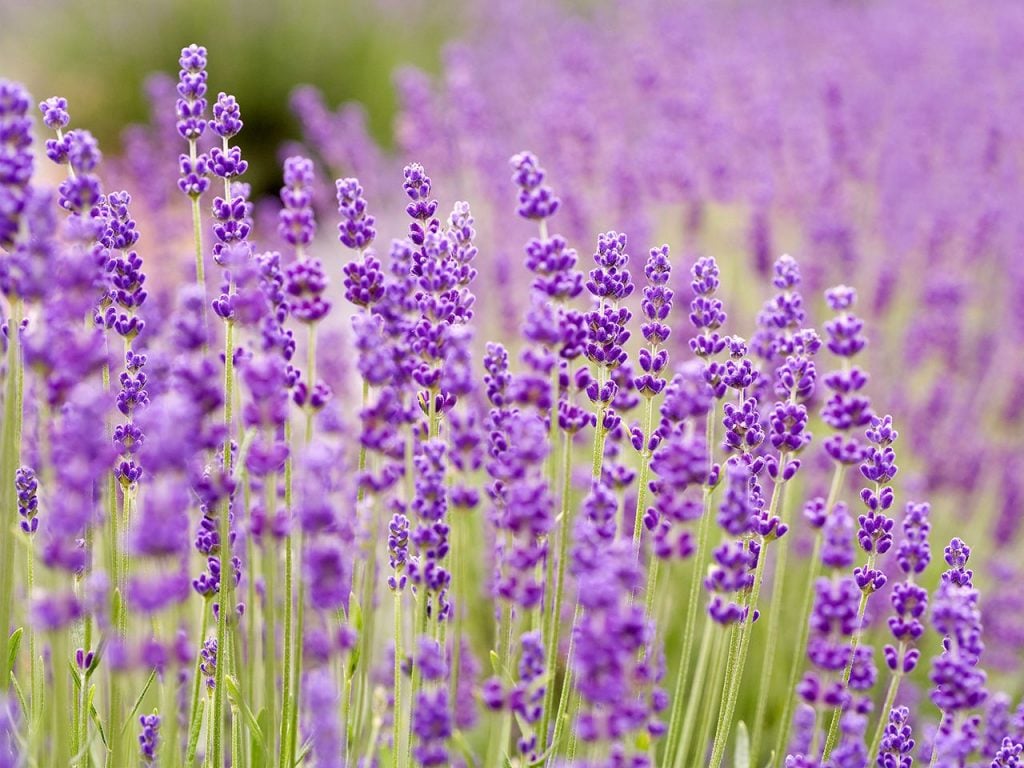
Lavender, a perennial plant, originates from the Mediterranean region. It thrives in well-draining soil, which should be slightly alkaline too. They need full sun exposure and moderate hydration.
Scientific Name: Lavandula
Blooming season: From mid to late summer, which usually commences in the month of June and lasts until August, Lavender produces its flowers. These flowers generally come in shades of blue, purple or pink and are highly aromatic.
Benefits:
- Aromatherapy: Lavender’s scent is recognised for its ability to soothe the mind and body, which has made it a common component in numerous relaxation products.
- Health: For many centuries, Lavender has been utilised to alleviate a diverse range of medical conditions, such as anxiety, depression, sleeplessness, and headaches.
- Beauty: Lavender’s calming and nourishing features have made it a trendy component in various beauty items. It is utilised to address acne, soothe irritated skin, and stimulate hair growth.
2. Bluebells
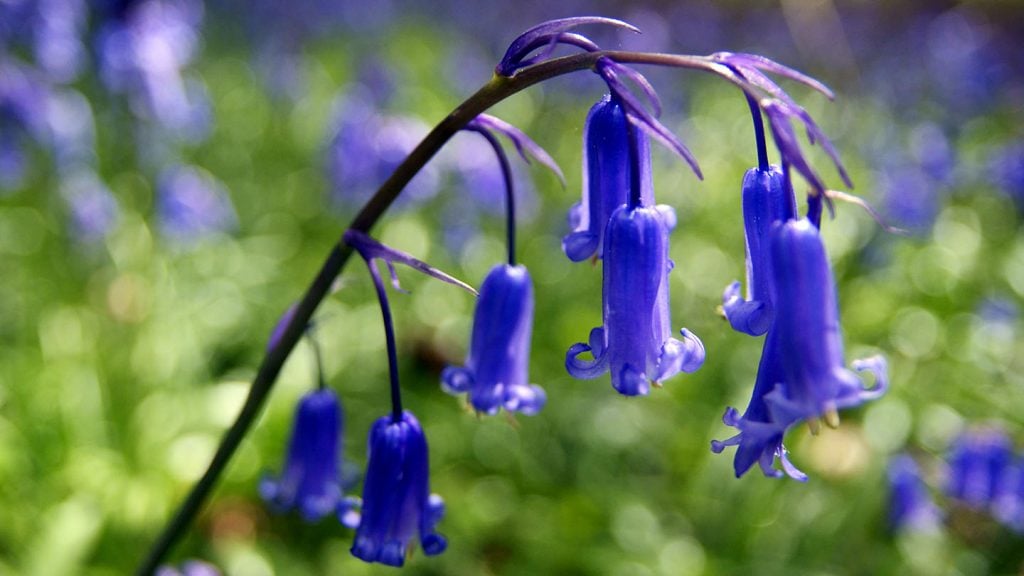
Bluebells flowers species are indigenous to the United Kingdom. They need soil that is well-draining soil, and they can survive varying degrees of sunlight, ranging from light exposure to the extreme. Moreover, their drought-resistant properties enable them to survive with scant watering, highlighting their ability to adapt to harsh environmental conditions.
Scientific Name: Hyacinthoides non-scripta
Blooming season: The bluebell species is known to blossom from the end of April to the beginning of June. This floral variety has lengthy, slender leaves in tandem with distinctive bell-shaped petals, which are tinted in shades of blue or purple, and give out pleasant and fragrant aromas.
Benefits:
- Ecological: Bluebell flowers play a vital role in the ecosystem, serving as a source of sustenance and shelter for many species, including bees, birds and butterflies.
- Cultural: The bluebell, with its beauty, holds a special place in the hearts of many in the United Kingdom. The enchanting flower is widely commemorated in numerous festivals and customs, notably the Bluebell Festival in the forest of Dean, where it serves as a symbol of rejuvenation and hope.
- Aesthetic: Bluebells, with their beauty, can be a delightful embellishment to any garden or woodland terrain, imparting a burst of colours to an otherwise boring view.
3. Larkspur

Delphiniums are lofty perennials that thrive best in well-drained soil with adequate moisture and full sun exposure. These plants produce towering spikes of a diverse array of flowers ranging in colours from blue to pink to white.
Scientific Name: Delphinium
Blooming season: Larkspur typically blooms from midsummer to early autumn, gracing the garden or landscape with its presence from June to August.
Benefits:
- Aesthetic: Larkspur is preferred for instilling a sense of drama and elevation in flower beds and borders, with their striking blue flowers as a particularly eye-catching feature.
- Cut flowers: Larkspur makes an exceptional choice of cut flowers, suitable for use in floral arrangements or even as dried flowers.
- Wildlife: Larkspur is a magnet for pollinators, including bees and butterflies, luring them to the garden and providing invaluable aid in supporting the local ecosystem.
4. Bluebeard
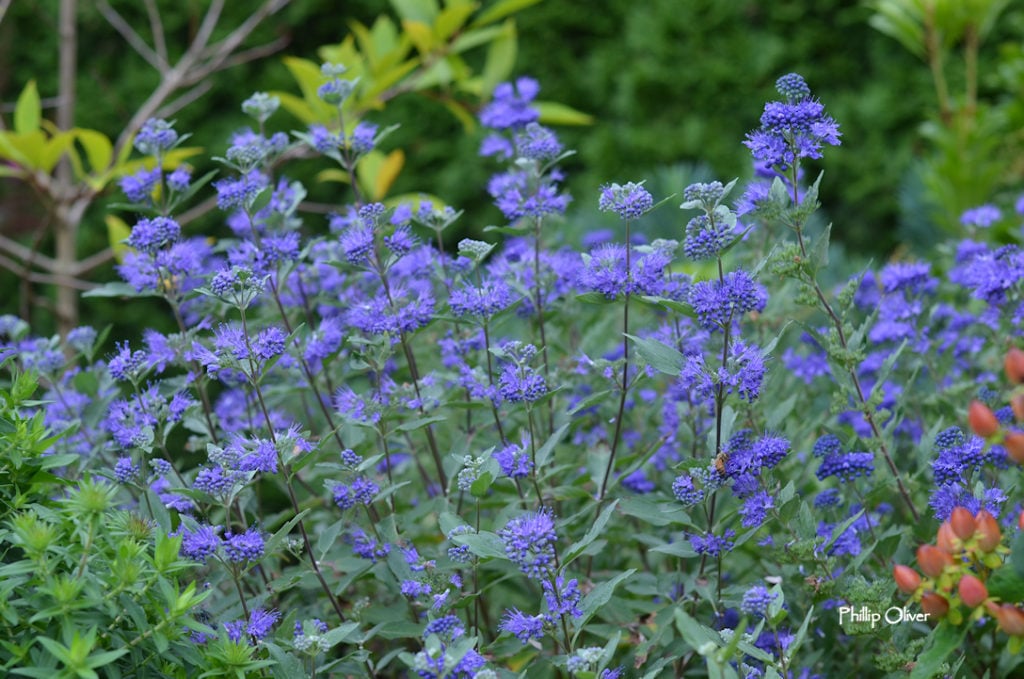
Bluebeard is a deciduous shrub that thrives in full sun exposure and well-draining soil. They produce clusters of small, blue-hued flowers in the latter stages of summer.
Scientific Name: Caryopteris
Blooming Season: Bluebeard blooming season starts from the end of summer to starting of autumn, which means from August to September. Bluebeard is a sought-after addition to gardens, particularly during peak flowering season.
Benefits:
- Aesthetic: Bluebeard is a low-maintenance flower which is beautiful. It produces a bunch of blue flowers, adding colour to the peak flowering season.
- Wildlife: It supports pollinators like bees and butterflies, which maintain the local ecosystem in the garden.
5. Forget-Me-Nots
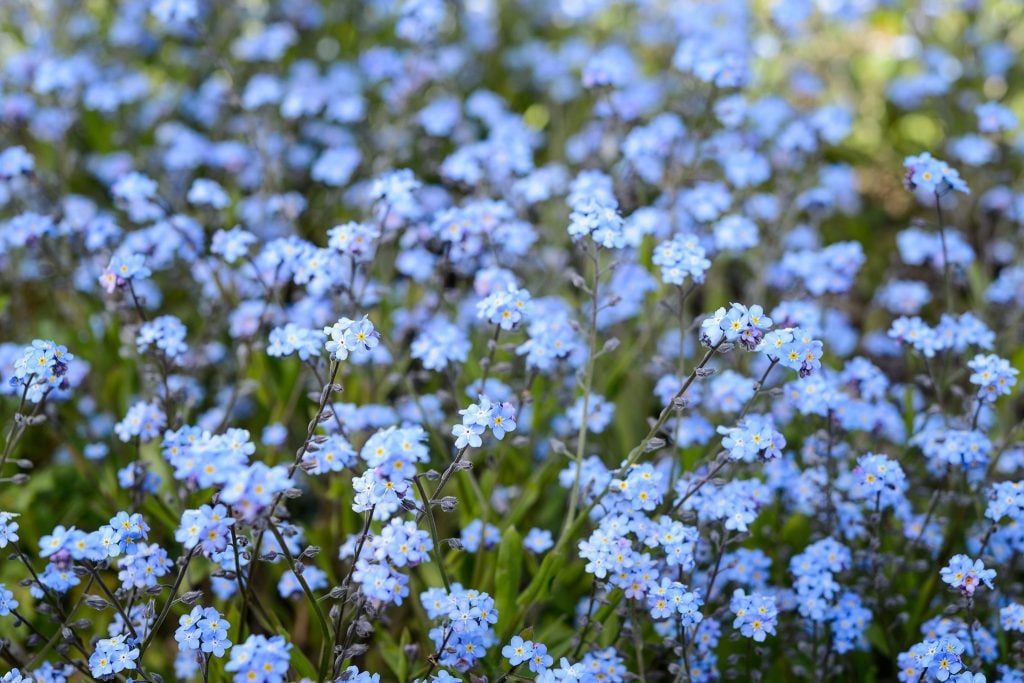
Forget-me-nots are delicate herbaceous flowers that hail from Europe and Asia but have adapted to various regions across the globe. They flourish in soil that is always moist and well-drained and thrive in areas with partial to full sun exposure. This plant species can grow well in various soil types, including sandy, loamy, and clay soils.
Scientific Name: Myosotis Sylvatica
Blooming Season: Forget-me-nots typically bloom during the end of spring and the start of summer, i.e., from May to June. These dainty and delicate plants produce small, vividly blue flower clusters endowed with a yellow centre.
Benefits:
- Ornamental use: Due to their alluringly beautiful blue flowers and ability to self-seed, which allows them to spread and naturalise over time, forget-me-nots have become highly favoured as ornamental plants in the garden.
- Medicinal use: For centuries, the flowers and leaves of forget-me-nots have been utilised in traditional medicine to treat respiratory ailments such as coughs, colds, and bronchitis.
- Ecological importance: The forget-me-nots serve as a crucial source of pollen and nectar for pollinators such as bees, rendering them immensely valuable in terms of sustaining biodiversity and upholding the health of ecosystems.
6. Russian Sage
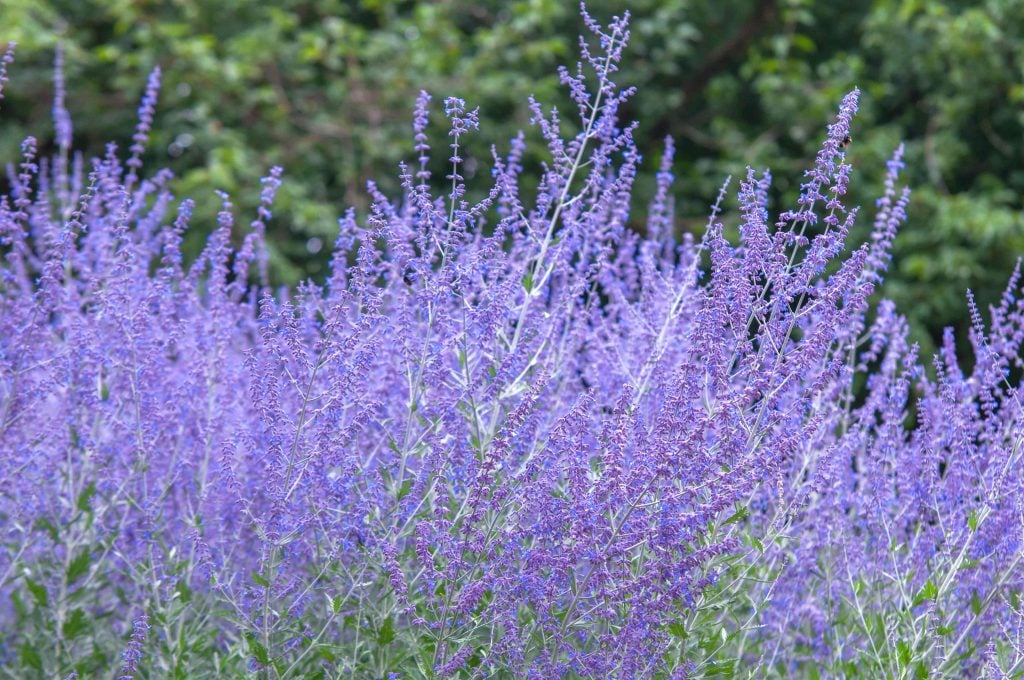
The Russian Sage, a robust and enduring flowering plant from central Asia, has been extensively cultivated across numerous regions worldwide. Flourishing best in well-drained soil and basking in full sunlight, it boasts the benefit of being drought-resistant once it takes root. The Russian Sage is primarily recognised for its silver-grey, aromatic leaves and elevated, spiky stems adorned with petite, lavender-blue blossoms.
Scientific Name: Perovskia Atriplicifolia
Blooming season: Russian Sage blossoms during the period between the middle of summer and the beginning of fall, which is typically from July to September.
Benefits:
- Ornamental use: Russian sage is a highly favoured garden plant, thanks to its stunning foliage and beautiful, eye-catching flowers. Its striking visual appeal makes it an excellent option for enhancing the texture and adding a splash of colour to any landscape.
- Medicinal use: Traditional medicine has long used the leaves of Russian Sage to address various health concerns, including respiratory problems, digestive issues and skin diseases.
- Ecological importance: Russian Sage is a highly valuable plant for gardens as it is essential for attracting pollinators like bees and butterflies, promoting a diverse and thriving ecosystem.
7. Blue Hibiscus
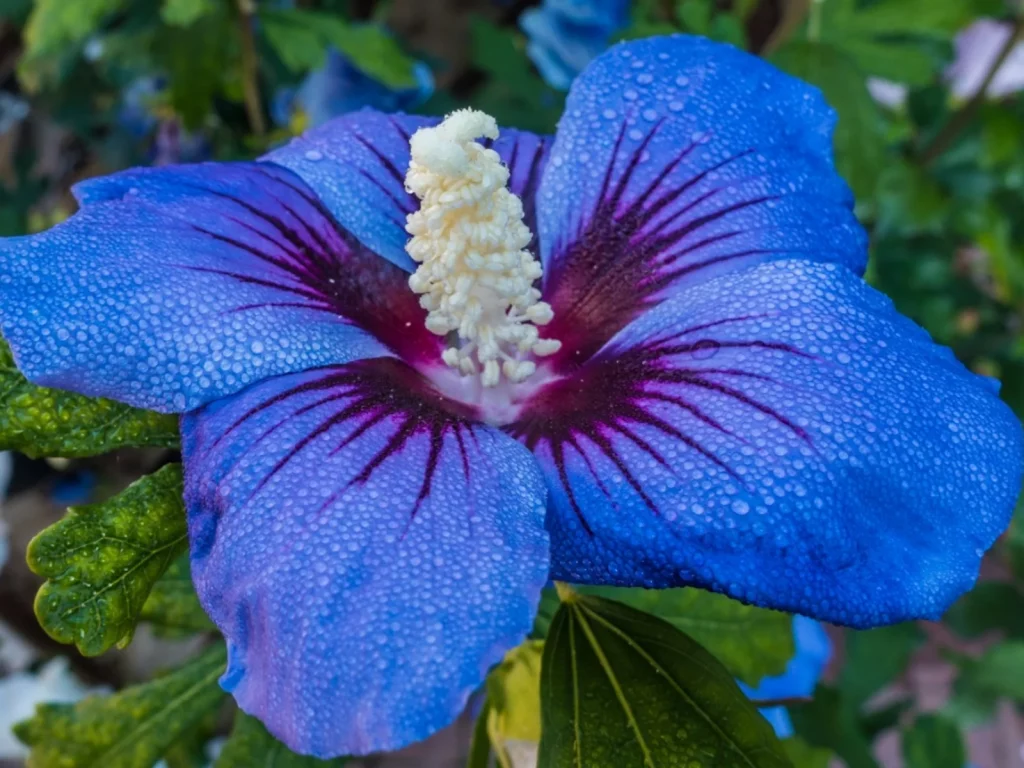
Blue Hibiscus is vital in promoting a healthy and diverse ecosystem in a garden as it serves as a crucial plant for attracting pollinators like bees and butterflies. It is also an excellent option for water-wise gardening since it requires minimal watering and is relatively low maintenance.
Scientific Name: Alyogyne Huegelii
Blooming season: Blue Hibiscus typically blossoms from late spring to early fall, generally from May to September. It is a large and captivating flower with an extended lifespan of several days.
Benefits:
- Ornamental use: Blue Hibiscus is a highly favoured garden plant owing to its breathtaking blue flowers that add a splash of colour and visual interest to any landscape.
- Medicinal use: In traditional medicine, the leaves and flowers of Blue Hibiscus have been utilised to remedy a variety of health issues such as coughs, sore throats, and fever.
- Ecological importance: This flower is essential for promoting a diverse and thriving ecosystem as it attracts crucial pollinators like bees and butterflies to gardens. Moreover, it requires minimal maintenance once established and is an ideal choice for water-wise gardening due to its low water requirements.
8. Butterfly Bush
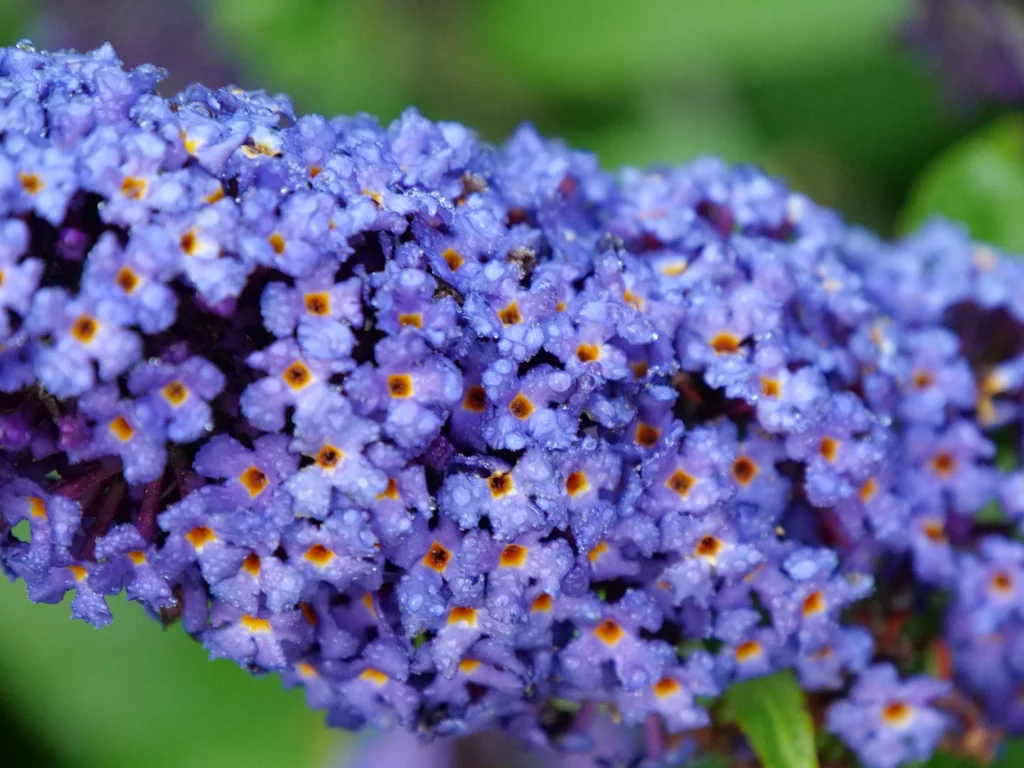
Butterfly Bush is a deciduous shrub that originated in China but is now widely grown in various regions. It prefers well-draining soil and full sun. It can tolerate drought once it has settled. Butterfly Bush is renowned for its lengthy, drooping branches and striking, sizeable floral spikes that come in a variety of hues, including blue.
Scientific Name: Buddleja Davidii
Blooming season: This flower produces its blooms from mid-summer to early fall, usually from July to September.
Benefits:
- Ornamental use: Butterfly Bush is hailed for its vibrant flowers and its capability of drawing in butterflies and other pollinators. Its variance in colours makes it a perfect choice for the landscape.
- Medicinal use: This flower serves a significant purpose in upholding biodiversity and preserving the well-being of the ecosystem. It is a precious reservoir of nectar and pollen that caters to many pollinating creatures.
- Ecological importance: The flower has been traditionally utilised in medicinal practices to remedy various disorders, such as fever, inflammation, and cough. Knowing that the plant can be harmful if consumed in large amounts is crucial.
9. Hydrangea
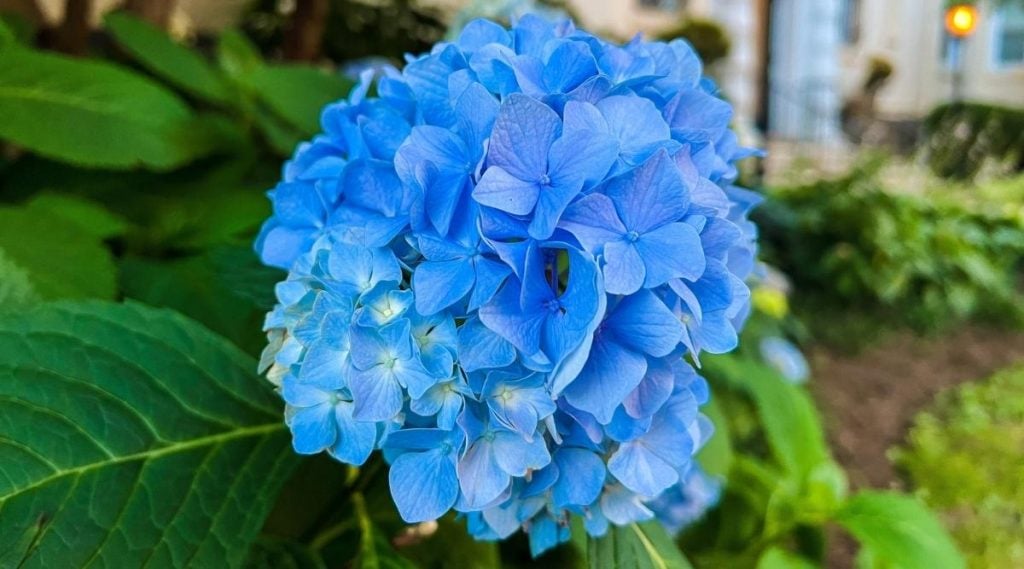
The hydrangea plant, a shrub that sheds its leaves annually, is indigenous to both Asia and the Americas. Its growth thrives in areas that possess well-hydrated soil and are partially shaded or fully exposed to the sun, depending on the variant. The hydrangea shrubs are renowned for their grandiose clusters of blossoms, which are obtainable in a vast array of hues, with blue being among the most prominent.
Scientific Name: Hydrangea macrophylla
Blooming season: Hydrangeas plants’ blooming season relies on the variant, typically occurring from the end of spring to the beginning of fall. Its sizeable flower cluster remains in bloom for numerous weeks and is frequently utilised as a part of a cut flower arrangement.
Benefits:
- Ornamental use: Hydrangea has earned popularity as an ornamental garden plant due to its showy flowers and resilience in adapting to diverse growing environments. The plant is available in an assortment of colours and sizes, rendering it a good option for landscaping purposes.
- Medicinal use: The leaves and roots have been part of customary medicine as a remedy for various health conditions, such as urinary tract infections and renal stones. Nevertheless, it is essential to know that it may be harmful if consumed excessively.
- Symbolic Meaning: Hydrangea is often linked to feelings of thankfulness, elegance and deep emotion, rendering it a sought-after option for gift-giving and special events, such as weddings and anniversaries.
10. Iris
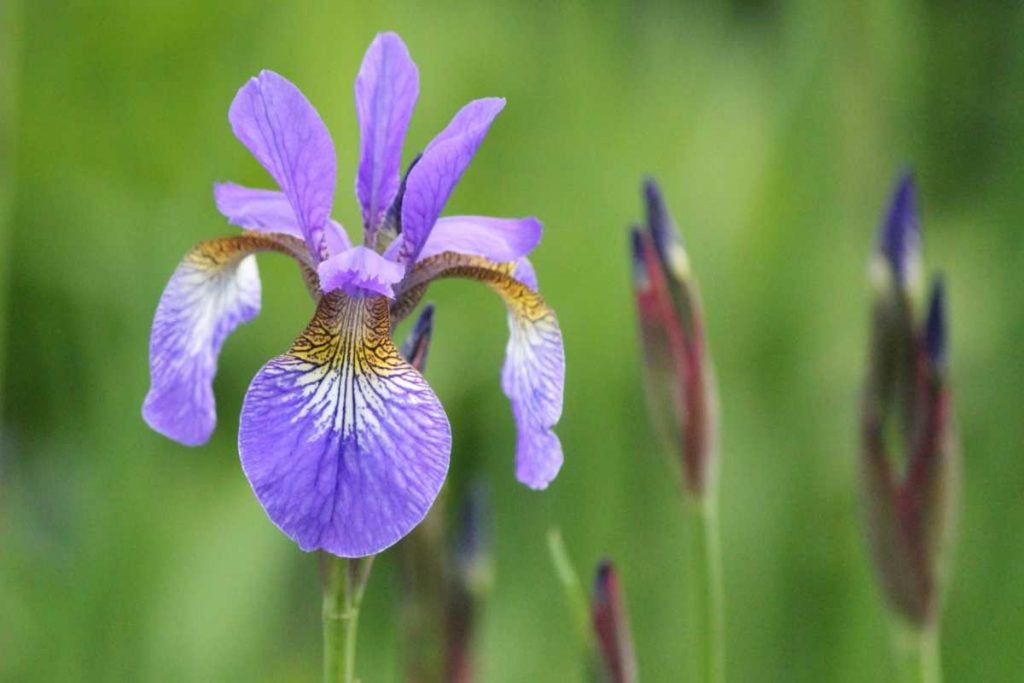
Iris belongs to the group of herbaceous perennials commonly found in several regions globally. They thrive optimally in a well-draining environment under full sun exposure, requiring minimal care once established. Iris is recognised for its distinct blossoms, exhibiting a remarkable composition of three petals and three sepals arranged in an exclusive pattern.
Scientific Name: Iris Germanica
Blooming season: Iris generally flowers from late spring to early summer, primarily between May and June. The blooms exhibit a spectrum of hues, including blue shades, and often an impressive and scented appearance.
Benefits:
- Ornamental use: Iris is a preferred plant for gardens due to its striking flowers and its ability to flourish in diverse growing environments. It is available in an assortment of sizes and colours, making it a versatile selection for landscaping purposes.
- Medicinal use: Iris root has a history of use in traditional medicine for treating various ailments such as skin, digestive, and respiratory issues. However, if it is taken in large quantities, it can be proven to be harmful lest it should only be used under the supervision of qualified healthcare professionals.
- Symbolic Meaning: Iris often correlated with attributes such as faith, wisdom, and hope, thus making it a frequently chosen option for commemorating significant occasions such as weddings and graduations. The flower is commonly given as a gift to convey the giver’s emotions and wishes.
Special Mention: Lily of the Nile
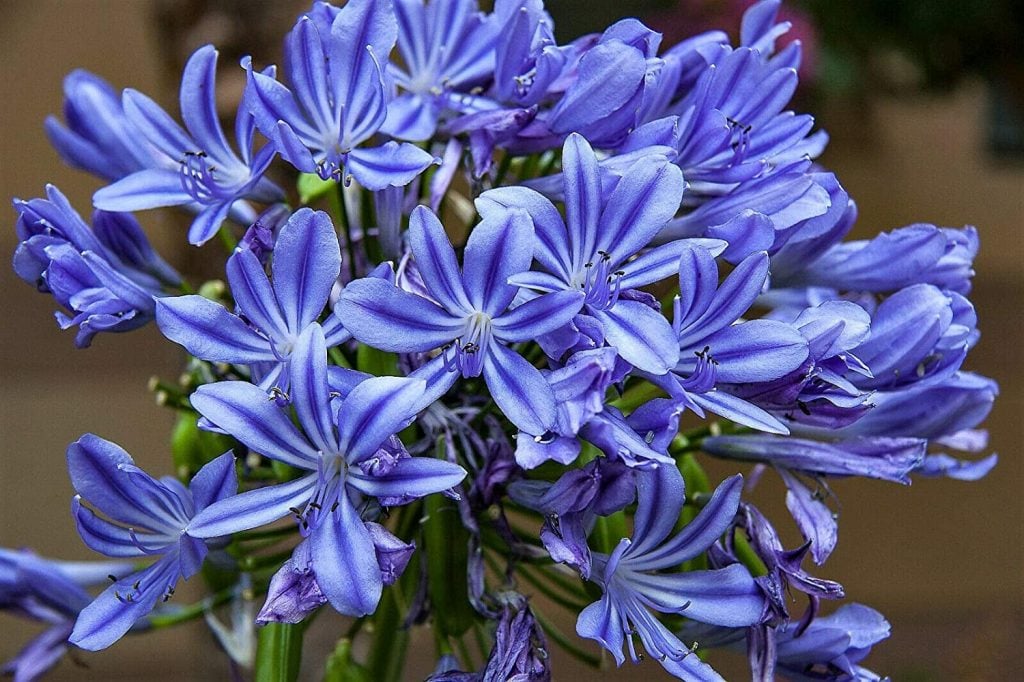
The Lily of the Nile is an evergreen herbaceous plant that is native to the southern region of Africa. This particular perennial flower needs a moderate amount of hydration and can withstand the blazing rays of the sun or even partial shade. Moreover, the plant needs well-draining soil that can thrive in all three major varieties of soil.
Scientific Name: Agapanthus Africanus
Blooming season: Lily of the Nile typically blooms in the summer season, somewhere around June to August.
Benefits:
- Ornamental use: The Lily of the Nile is a common choice for landscape projects due to its beautiful blooms. It doesn’t come in different sizes, but one option is enough to look the best.
- Low-maintenance: This flower is relatively simple to care for and can endure difficult circumstances, hence making it a better alternative for gardens that demands minimal upkeep or for horticulturists who are pressed for time and cannot give much effort towards plant maintenance. However, they need extra protection during the cold season.
- Medicinal use: Lily of the Nile is used to remedy a lot of diseases which include coughs, high temperature, and minor kidney issues. Nevertheless, it is important to know that these applications have not undergone scientific validation, thereby making it essential to seek counsel from a certified medical practitioner prior to utilising any plant for a therapeutic motive.
Caring for Blue-Flowering Shrubs and Bushes
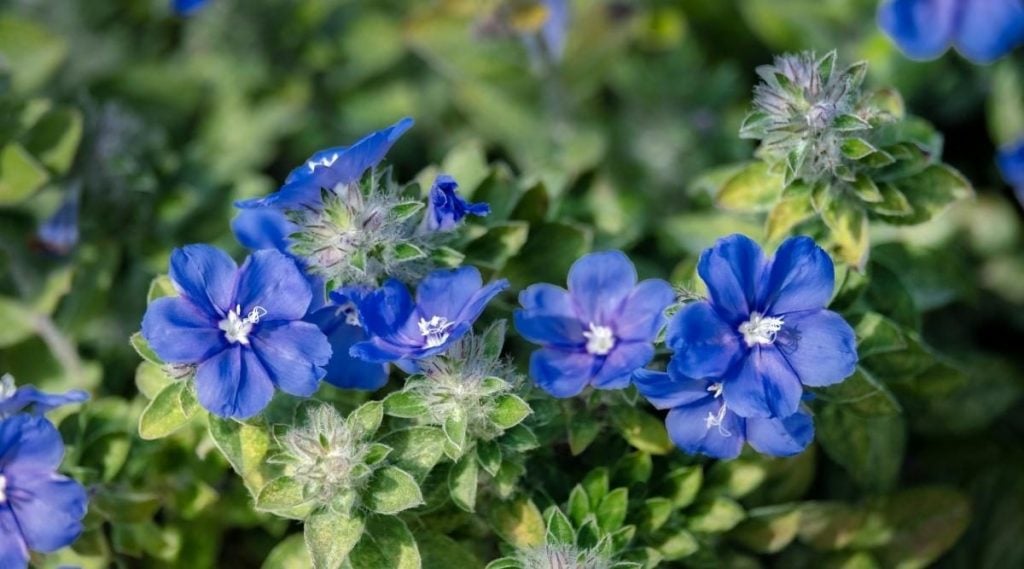
1. Right Location
Most Shrubs that produce blue flowers generally thrive when exposed to full sunlight or partially shaded region and when planted in adequately drained soil. It is recommended that you carefully choose a location that receives a minimum of six hours of daily sunshine and has ideal drainage.
2. Watering
It is crucial to ensure that your bush with blue flowers is watered properly and frequently, especially during the growing season and particularly in hot and arid weather. It is important to exercise caution not to overwater them because it can result in root rot.
3. Fertilisation
To encourage growth and blooms, applying a slow-release fertiliser during the springtime and a balanced fertiliser in the middle of the summer season to this bush with blue flowers is recommended.
4. Mulching
In order to maintain moisture levels, prevent weak growth, and regulate soil temperature, it is advisable to spread a layer of organic mulch, such as wood chips or shredded leaves, around the foundation of the shrub.
5. Manage Pest and Disease
It is important to be vigilant and watch out for prevalent pests and diseases that could harm your bush with blue flowers, such as aphids, spider mites, powdery mildew, and leaf spot. Use appropriate insecticides and fungicides if necessary and quickly eliminate any infected leaves or branches.
6. Caring in Winter
Certainly, blue-flowering shrubs may need protection during winter, particularly in colder climates. To prevent damage from frost and snow, apply a layer of mulch around the shrub’s base, and cover it with burlap or other protective material.
By adhering to these straightforward guidelines, you can assist in the continued health and vibrancy of your blue-flowing shrubs and bushes and ensure a stunning display of blooms for years to come.
Summing It Up!
Shrub and bush with blue flowers are capable of bestowing an air of sophistication, tranquillity, and a touch of loveliness upon any garden, becking bees and butterflies while also enlivening the outdoor area with energy and dynamism. Electing to feature blue flowers in urban gardens can be a wise decision as the blue hue functions as an effective sound absorber.
Nonetheless, taking care of blue-blooming shrubs and bushes is crucial, and horticulturists should select a spot that receives a minimum of six hours of sunlight daily, exercise regularity when watering, add fertilisers, mulch, and pest and disease management, as well as safeguard the plants during the winter months.
This article presents a collection of ten blue-blooming shrubs and bushes, which includes lavender, bluebells, and delphiniums, spotlighting their benefits like aromatherapy, health, ecological, cultural, and aesthetic advantages.

